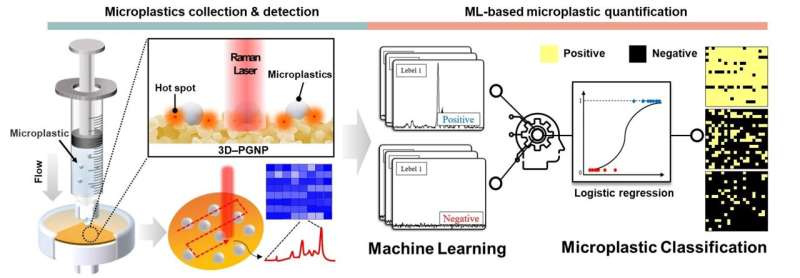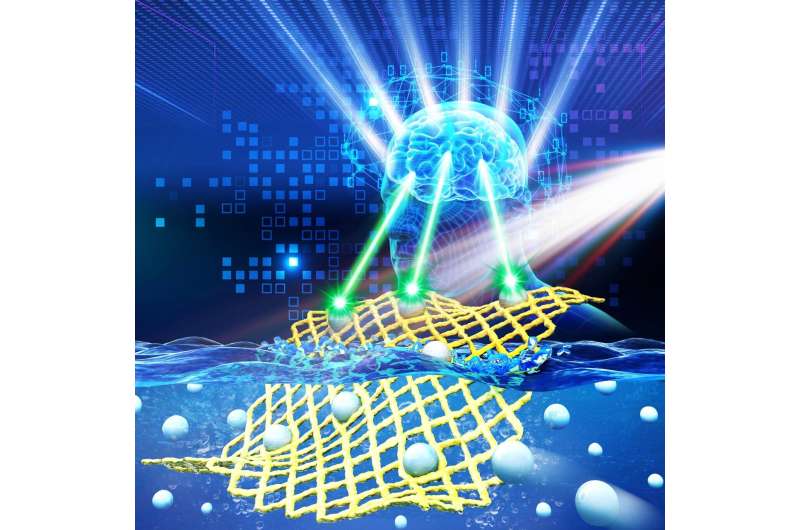This article has been reviewed according to Science X's editorial process and policies. Editors have highlighted the following attributes while ensuring the content's credibility:
fact-checked
peer-reviewed publication
trusted source
proofread
Scientists develop microplastics detection kit with AI technology

A research team led by Dr. Ho Sang Jung of the Department of Nano-Bio Convergence at the Korea Institute of Materials Science (KIMS), a research institute under the Ministry of Science and ICT, in collaboration with the KOTITI Testing & Research Institute, has developed the world's first technology to rapidly and highly sensitively detect microplastics (MPs), which can cause human and genetic toxicity through environmental pollution and the food chain.
The research results were published on 10 September in Advanced Functional Materials.
The on-site applicable MPs detection technology developed by the research team is a kit-type technology. When filtered through a syringe filter-type MP detection kit, the type, number, and distribution of MPs can be identified within 20 minutes without any pre-treatment.
The research team focused on the fact that MPs can be filtered out. The team synthesized a plasmonic material in the form of a nanopocket that can capture MPs on the surface of a paper filter with microscale pores and amplify the optical signal of the captured MPs. When a sample solution containing MPs is injected through a syringe, the Raman spectral signal of the MPs is amplified on the nanopocket-type plasmonic material, enabling highly sensitive detection. The technology can also be used to detect MPs at the nanometer scale.
In addition, the research team pre-trained an artificial intelligence (AI) system on the unique Raman spectroscopy signals of MPs, so that the artificial intelligence (AI) can determine whether the detected signal corresponds to MPs, even if there are interfering elements in the sample. This technology makes it possible to accurately identify MPs in complex environments or human samples, as well as their concentration, distribution, and type.
Existing technologies for detecting MPs have been difficult to use in the field. This is because it requires complex pre-treatment, high-performance equipment, and analysis by skilled researchers. This technology replaces the pre-treatment process in the form of a filter and improves the sensitivity of the material, rather than increasing the performance of the equipment.
The biggest differentiator is that the analytical skills of skilled researchers have been replaced by machine learning. Also, The detection device has the advantage of using a portable Raman spectrometer, which increases the possibility of on-site detection.
At present, questions continue to arise about the environmental pollution and human risk related to MPs at home and abroad. It has been reported that MPs are easily released from our everyday products such as beverage containers and snack bags. However, to date, there is no method to detect small MPs of micro or nano size, so there is a need to develop technology to establish an international standard detection method.
Since this could lead to future regulations on plastic products and food and beverage containers, it is meaningful that we have developed technology to preemptively overcome import and export regulations due to future environmental problems through the development of source technology. Another advantage of this technology is that the general public can easily use it when necessary since the sensor is made as a kit.

Dr. Ho Sang Jung, a senior researcher at KIMS who developed this technology said, "If this technology is commercialized, the technology for detecting MPs universally will be more easily and rapidly disseminated" and "Based on this, KIMS will continue to spare no effort in developing material technologies for the safety of the people and future generations," he added.
The research team plans to collaborate with the KOTITI Testing & Research Institute to standardize MPs detection technology in the future. Meanwhile, the research team is currently conducting follow-up research to detect MPs by size and evaluate their toxicity to the human body.
More information: Jun Young Kim et al, 3D Plasmonic Gold Nanopocket Structure for SERS Machine Learning‐Based Microplastic Detection, Advanced Functional Materials (2023). DOI: 10.1002/adfm.202307584
Journal information: Advanced Functional Materials
Provided by Korea Institute of Science and Technology



















